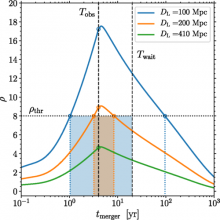
Abstract
Joint gravitational-wave detections of stellar-mass black-hole binaries by ground- and space-based observatories will provide unprecedented opportunities for fundamental physics and astronomy. We present a semianalytic method to estimate multiband event rates by combining selection effects of ground-based interferometers (like LIGO/Virgo) and space missions (like LISA). We forecast the expected number of multiband detections first by using information from current LIGO/Virgo data, and then through population synthesis simulations of binary stars. We estimate that few to tens of LISA detections can be used to predict mergers detectable on the ground. Conversely, hundreds of events could potentially be extracted from the LISA data stream using prior information from ground detections. In general, the merger signal of binaries observable by LISA is strong enough to be unambiguously identified by both current and future ground-based detectors. Therefore third-generation detectors will not increase the number of multiband detections compared to LIGO/Virgo. We use population synthesis simulations of isolated binary stars to explore some of the stellar physics that could be constrained with multiband events, and we show that specific formation pathways might be overrepresented in multiband events compared to ground-only detections.